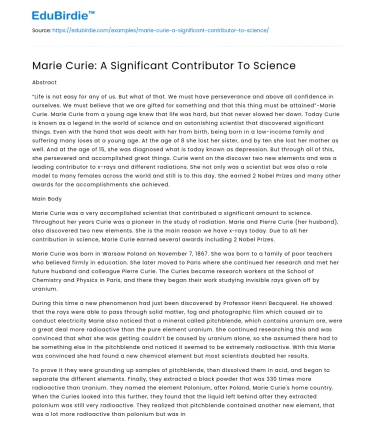Abstract
“Life is not easy for any of us. But what of that. We must have perseverance and above all confidence in ourselves. We must believe that we are gifted for something and that this thing must be attained”-Marie Curie. Marie Curie from a young age knew that life was hard, but that never slowed her down. Today Curie is known as a legend in the world of science and an astonishing scientist that discovered significant things. Even with the hand that was dealt with her from birth, being born in a low-income family and suffering many loses at a young age. At the age of 8 she lost her sister, and by ten she lost her mother as well. And at the age of 15, she was diagnosed what is today known as depression. But through all of this, she persevered and accomplished great things. Curie went on the discover two new elements and was a leading contributor to x-rays and different radiations. She not only was a scientist but was also a role model to many females across the world and still is to this day. She earned 2 Nobel Prizes and many other awards for the accomplishments she achieved.
Save your time!
We can take care of your essay
- Proper editing and formatting
- Free revision, title page, and bibliography
- Flexible prices and money-back guarantee
Main Body
Marie Curie was a very accomplished scientist that contributed a significant amount to science. Throughout her years Curie was a pioneer in the study of radiation. Marie and Pierre Curie (her husband), also discovered two new elements. She is the main reason we have x-rays today. Due to all her contribution in science, Marie Curie earned several awards including 2 Nobel Prizes.
Marie Curie was born in Warsaw Poland on November 7, 1867. She was born to a family of poor teachers who believed firmly in education. She later moved to Paris where she continued her research and met her future husband and colleague Pierre Curie. The Curies became research workers at the School of Chemistry and Physics in Paris, and there they began their work studying invisible rays given off by uranium.
During this time a new phenomenon had just been discovered by Professor Henri Becquerel. He showed that the rays were able to pass through solid matter, fog and photographic film which caused air to conduct electricity Marie also noticed that a mineral called pitchblende, which contains uranium ore, were a great deal more radioactive than the pure element uranium. She continued researching this and was convinced that what she was getting couldn’t be caused by uranium alone, so she assumed there had to be something else in the pitchblende and noticed it seemed to be extremely radioactive. With this Marie was convinced she had found a new chemical element but most scientists doubted her results.
To prove it they were grounding up samples of pitchblende, then dissolved them in acid, and began to separate the different elements. Finally, they extracted a black powder that was 330 times more radioactive than Uranium. They named the element Polonium, after Poland, Marie Curie's home country. When the Curies looked into this further, they found that the liquid left behind after they extracted polonium was still very radioactive. They realized that pitchblende contained another new element, that was a lot more radioactive than polonium but was in even smaller quantities. In 1898, Marie and her husband finally published strong evidence supporting the existence of the new element which they called radium.
Marie chose to investigate the rays from uranium, and this was a new and exciting field to work in. She discovered that uranium rays electrically charge the air they pass through. Such air can conduct electricity. Marie detected this using an electrometer her husband and his brother had invented. She also noticed the number of rays coming from uranium depends on the amount of uranium present and has nothing to do with the chemical form of uranium from this she theorized accurately that radium, follows necessarily that the atom of radium breaks up into sub atoms of different sizes, unless these projectiles come from the atoms of the surrounding gas, disintegrated by the action of radium; but this view would likewise lead us to believe that the stability of atoms is not absolute.
Curie’s work was significant in the development of x-rays in surgeries. During World War 1 Curie helped to give ambulances x-ray equipment, and she herself drove these ambulances in the front lines. The International Red Cross even made her head of the radiological services, and she held medical courses that taught doctors and other therapeutic professionals new techniques to use the equipment. Despite all the success Marie Curie had in her life she was still doubted on and discriminated by many male scientists. Due to that she never indeed received many financial benefits. Since she was exposed to so much radiation due to her research in the late 1920s, her health began to suffer. She died July 4, 1934, of leukemia due to all the exposure to radiation.
The significance of Marie Curie works shown by all the awards bestowed upon her. Together with her husband, she received half of the Nobel Prize for Physics in 1903. In 1911 she won a second Nobel Prize for her work in radioactivity, and in 1921, the president of the United States, on behalf of the women of America, presented her with one gram of radium in recognition to her service to science. As the discoverer of two new elements and a critical factor in radiation research. Her legacy lives through her work and as she continues to be a role model for many female scientists to this day.






 Stuck on your essay?
Stuck on your essay?

